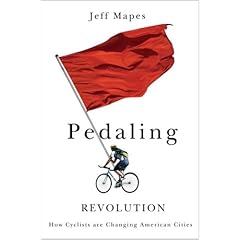
A Book Review by Rick Price, Ph.D.
(by Jeff Mapes, Oregon State University Press, 2009)
The author of Pedaling Revolution, Jeff Mapes, covers politics for the Portland Oregonian;, he is a blogger, a bicycle commuter, and by virtue of having spent nights and weekends from 2004 until April of 2008 thinking about and writing this book, he has become a bicycle advocate. Put him on your list of people to invite to your bike summit or alternative energy fair as recently Mapes was the keynote speaker at such disparate events as the
 energy - SolWestFair - in John Day, Oregon and the Miami Valley Cyclists’ Summit in Dayton, Ohio. (Oh yeah, did I mention, that Mapes’ family just purchased a cargo bike with the capacity to haul 400 lbs of cargo? Now that’s the sign of a committed bicycle advocate.)
energy - SolWestFair - in John Day, Oregon and the Miami Valley Cyclists’ Summit in Dayton, Ohio. (Oh yeah, did I mention, that Mapes’ family just purchased a cargo bike with the capacity to haul 400 lbs of cargo? Now that’s the sign of a committed bicycle advocate.)So what makes Pedaling Revolution a great book? And what makes Jeff Mapes the latest candidate as spokesperson for our very own bicycle “revolution”? Stories, that’s what, the stock-in-trade of the “literary journalist.”
Mapes is no John McPhee or Tracy Kidder just yet, but he has pulled together a great collection of interviews, stories, and accounts of personal encounters with the people who have made this revolution. And in so doing he reminds us of the value of personal passion, local advocacy, and the role that we all might aspire to play in the revolution. I especially like the nuggets of history and advocacy that he has dredged up in his quest to understand the resurgence of the bicycle in this country.
Take Davis, CA, for example. Why is Davis, widely known as “bike town USA,” head and shoulders above the rest of us for its bike culture? In part, explains Mapes, because of the seeds sown by Davis’s University Chancellor Emil Mrak in the early 1960s. Mrak loved to bicycle and when he became Chancellor he asked his planners and architects to “plan for a bicycle-riding, tree-lined campus.” Then he banned motor vehicles from the central part of campus. The rest is history.
There are other hints of how one person can effect change and help sow the seeds of a bicycle revolution. For example, where did all those bike paths in our bicycle friendly cities come from anyway? Well, you may remember New York Senator Daniel Patrick Moynihan. He was a sociology professor and as a young academic Moynihan wrote an article in 1960 called “New Roads and Urban Chaos,” in which he predicted that urban chaos will break out if States were allowed to build the Interstate Highway system with unrestricted funding from the federal government.
Thirty years later, as chair of the Senate Environment and Public Works subcommittee, Moynihan created local metropolitan planning organizations designed to provide a check and balance on every state’s “roads only” Department of Transportation ( you know, the DOTs) and to mandate that these planning agencies fund “transportation enhancements” that included bike paths and other multi-modal facilities. The result of that legislation is a legacy of nearly two decades of funding for bike paths and bicycle and pedestrian coordinators at the State and city level across the country.
From this personal level of stories about key individuals who have influenced bicycling in the US, Mapes expands his narrative to include a series of readable case studies of cities in Europe and the US. He writes about Amsterdam, Copenhagen and Paris, Chicago, San Francisco and Seattle, and he goes into depth on Davis, Portland, and bicycling in New York City.
You can’t write about the bicycle revolution in the US without exploring the roll of Critical Mass (if you aren’t familiar with “critical mass” your primer is here: http://en.wikipedia.org/wiki/Critical_Mass), urban bike messenger culture, and the controversy within the bicycle community itself over the assertion of people like John Forester, that “cyclists fare best when they act and are treated as drivers of vehicles.” Mapes does all of this and he does it well.
After his great introduction to the recent history of bicycling and bicycle advocacy, Mapes wraps up his narrative in three chapters on bicycle safety, health, and “Bringing Kids Back to Bikes.” It is, in short, a call to arms, to get involved and to bring the revolution to your community. What’s holding you back?
2 comments:
Thanks for the very nice and well-written review.
Pedal on!
Jeff Mapes
This is an exciting review!
-Ted, Sydney, NSW.
Post a Comment